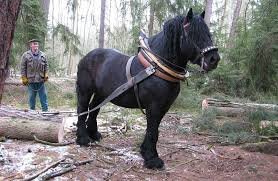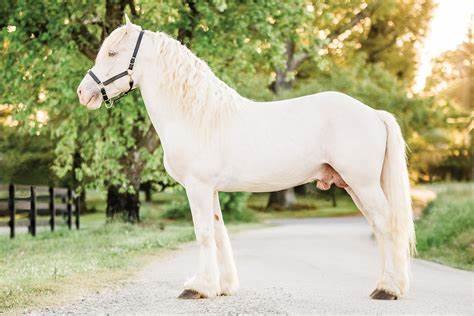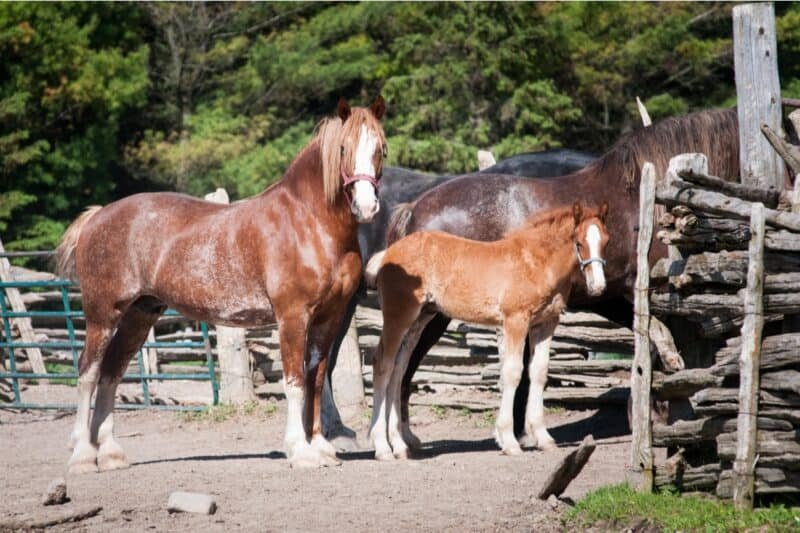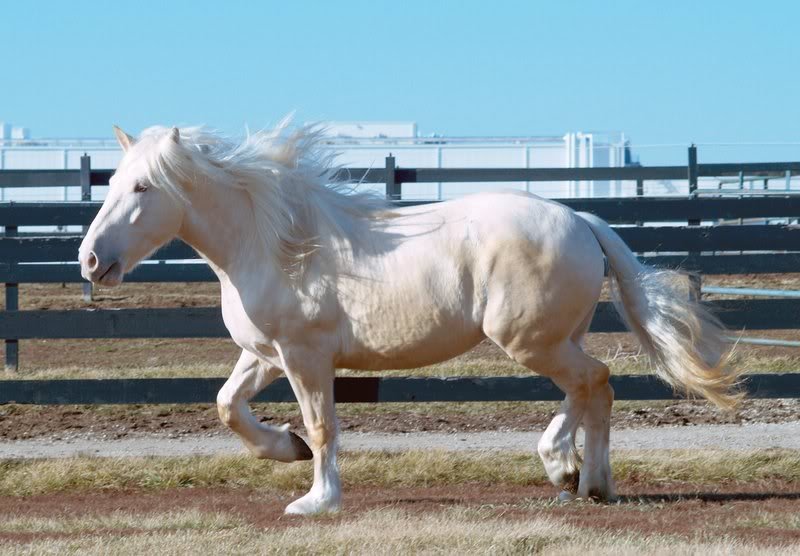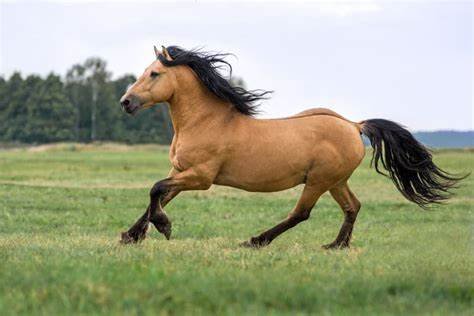Cream draft horses, known for their unique coat color and impressive strength, have been integral to various forms of labor throughout history. One of the key areas where these horses have excelled is logging. In the past, when machinery was either unavailable or impractical, horses played a crucial role in moving timber and other heavy loads in the logging industry. Today, despite the dominance of mechanized equipment, cream draft horses still find a place in selective logging, sustainable practices, and areas where machinery may be less feasible. In this post, we’ll explore the important role of cream draft horses in logging, their unique contributions, and why they continue to be valuable assets in certain forestry practices.
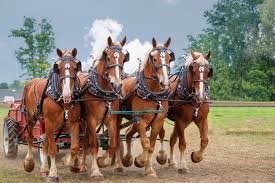
1. Historical Use of Draft Horses in Logging
The use of draft horses in logging dates back centuries, long before the advent of modern machinery. These horses were relied upon in forests to pull logs out of rugged terrain, making them essential in timber production. Traditionally, draft horses like cream draft horses were used for tasks such as:
- Hauling Logs: Horses were trained to pull heavy logs from forests to the processing mills. This often required navigating difficult and uneven terrain, where mechanized vehicles struggled to operate. Their ability to maneuver through tight spaces made draft horses invaluable.
- Skidding: This term refers to the process of dragging logs across the ground, often with a sledge or simple harness system. Draft horses, known for their strength, were perfectly suited for skidding, as they could pull logs over long distances while minimizing damage to the forest floor.
- River Driving: In some cases, logs were floated down rivers to sawmills, but draft horses were used to pull logs to riverbanks or assist in loading them onto rafts for transport. This labor-intensive process was made more efficient by the sheer power of horses like the cream draft horse.
During this era, draft horses not only helped cut down trees and transport timber, but they also allowed loggers to access remote and challenging areas, making timber harvesting far more efficient.
2. Benefits of Using Draft Horses in Logging
While machines may be the first tool that comes to mind for most logging operations today, there are several advantages to using draft horses, especially in selective logging and environmentally-conscious forestry practices. Cream draft horses, in particular, offer some unique benefits, including:
- Minimal Environmental Impact: One of the most significant advantages of using cream draft horses in logging is their low environmental impact. Unlike heavy machinery, which can leave ruts, compact soil, and damage vegetation, horses move more gently through the forest. They are particularly useful in sensitive environments, where the use of machinery may cause long-term damage to the soil or disrupt local ecosystems.
- Ability to Access Remote Areas: Logging sites that are located in areas with difficult terrain or narrow paths are often inaccessible to large machines. Cream draft horses are highly agile, able to navigate steep hillsides and densely wooded areas with relative ease. This makes them invaluable for selective logging, where only certain trees are harvested, and access is needed in areas where machines cannot reach.
- Sustainability: In the context of sustainable forestry, draft horses are seen as an eco-friendly alternative to mechanized logging. Their use reduces reliance on fossil fuels and helps lower carbon emissions, aligning with eco-conscious timber harvesting practices that focus on sustainability.
- Gentle on Forest Floors: Draft horses, especially cream draft horses, are known for their ability to move quietly and delicately through the forest without causing significant disruption to the ground. Unlike large machines, which can cause soil compaction, erosion, and damage to the forest understory, horses maintain the natural structure of the forest floor.
3. Training and Techniques for Logging
To perform logging tasks, draft horses, including cream draft horses, must undergo specialized training. These horses are trained to carry out a variety of duties in the logging industry, including:
- Harness Training: Horses are taught to wear harnesses that attach to a sled or log skidder, which is used to pull logs. They learn to respond to the driver’s commands, allowing them to work effectively and safely. Proper harnessing ensures that the horse can pull heavy loads without strain.
- Navigating Terrain: One of the most important skills for draft horses in logging is navigating rough and uneven terrain. Horses are taught to move through forests, over hills, and along narrow paths without getting stuck or causing harm to the environment.
- Pulling Logs: The horses must also be trained to skid logs across the ground. This involves pulling logs over varying distances and obstacles. They learn to use their strength efficiently while minimizing the risk of injury to themselves or damage to the logs.
- Teamwork with the Logger: Successful logging with draft horses requires a deep bond between the horse and the handler. Loggers must develop a clear understanding of how to communicate with their horses, whether through voice commands or physical cues, to ensure a smooth and efficient operation.
4. Modern-Day Use of Cream Draft Horses in Logging
Despite the advancement of logging technology, cream draft horses still have a place in modern forestry, particularly in certain contexts where their strength and agility are needed. Today, draft horses are used in:
- Selective Logging: In environmentally sensitive areas where minimizing disturbance to the ecosystem is crucial, draft horses are often preferred over machines. They are used for selective cutting, where only specific trees are harvested to ensure the long-term health of the forest. By using horses for these tasks, loggers can reduce the impact of logging on the forest.
- Historical and Educational Demonstrations: Cream draft horses are also used in historical reenactments and educational demonstrations to showcase traditional logging methods. These demonstrations are popular at museums, logging fairs, and historical festivals, where visitors can learn about the role of horses in timber harvesting.
- Eco-Friendly Forestry Projects: In some parts of the world, there is a growing movement toward more sustainable and eco-friendly logging practices. Cream draft horses are being used in small-scale timber harvesting projects, where they contribute to the forest economy without the need for large machines. Their use aligns with the values of sustainability and ecological conservation.
5. Challenges and Considerations in Using Draft Horses for Logging
While there are many benefits to using cream draft horses in logging, there are some challenges and considerations:
- Physical Demand on Horses: Logging can be physically demanding on horses, particularly in challenging terrain or when hauling heavy loads. It’s essential to ensure the horses are fit, well-trained, and given adequate rest between work sessions to prevent fatigue and injury.
- Cost and Training: The cost of training and maintaining a team of horses, along with the necessary equipment, can be high. However, for those who prioritize sustainable practices, these costs are often seen as an investment in a more environmentally friendly and efficient logging system.
- Limited Scale: While draft horses can be highly effective for smaller, more selective logging operations, they may not be suitable for large-scale timber production, where machines can process far greater volumes of wood in less time.
Conclusion
Cream draft horses have long played an important role in logging, contributing their strength, agility, and gentle impact on the environment. While their use in the logging industry has decreased with the rise of mechanized equipment, these remarkable horses are still valued for their role in sustainable, selective logging practices. Whether they are used in eco-friendly forestry projects, historical demonstrations, or remote logging sites, cream draft horses continue to be a symbol of power, agility, and environmental stewardship in the logging industry.







